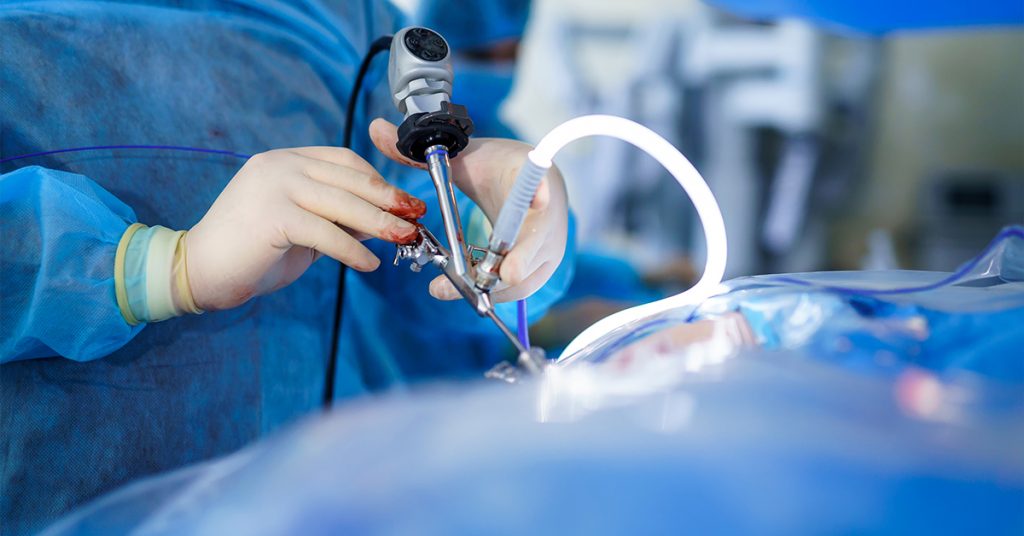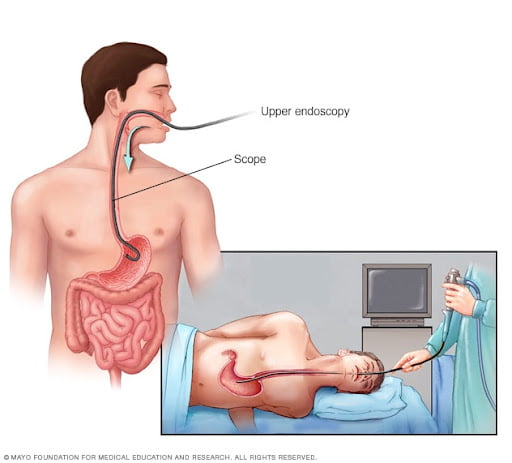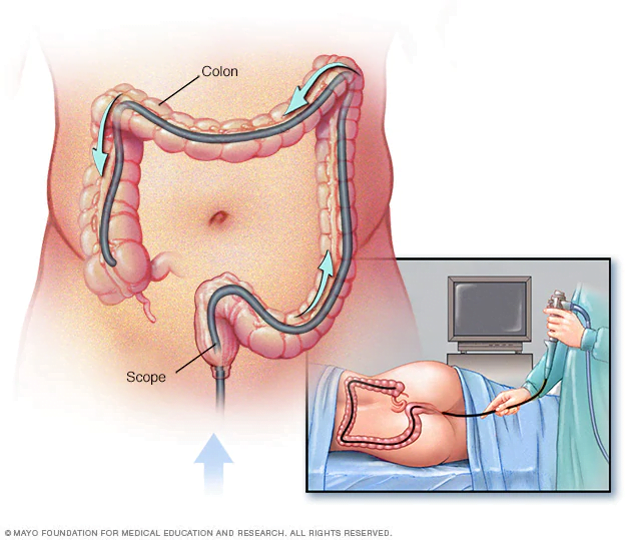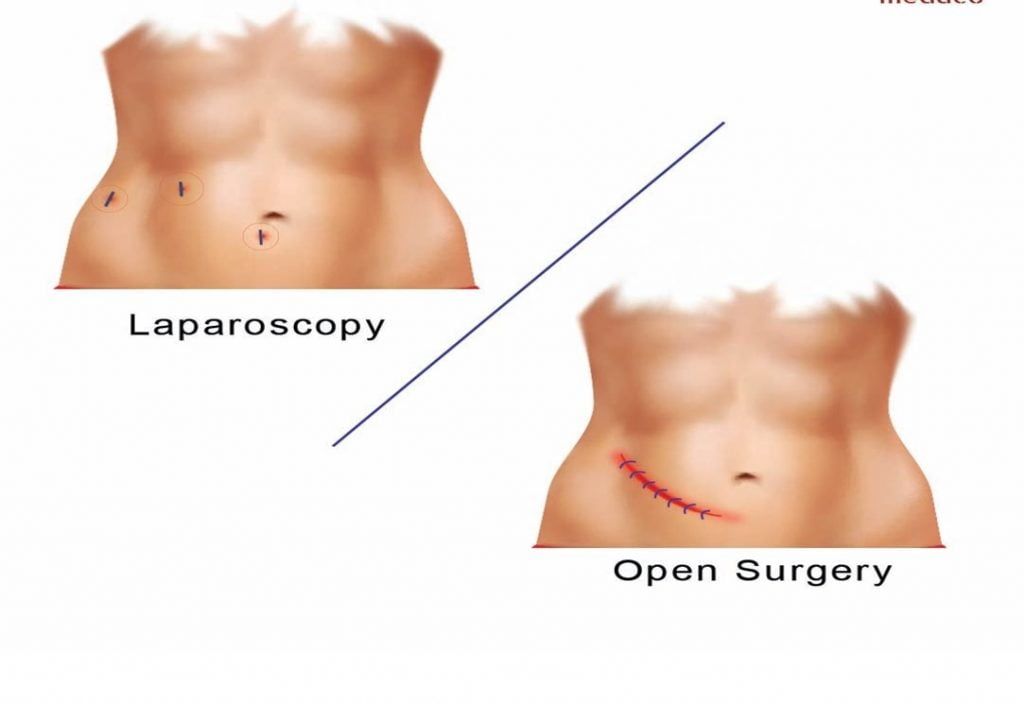Procedures

PROCEDURES
1. Endoscopy

- An upper endoscopy, also called an upper gastrointestinal endoscopy, is a procedure used to visually examine your upper digestive system. This is done with the help of a tiny camera on the end of a long, flexible tube. A specialist in diseases of the digestive system (gastroenterologist) uses an endoscopy to diagnose and sometimes treat conditions that affect the upper part of the digestive system.
- The medical term for an upper endoscopy is esophagogastroduodenoscopy. You may have an upper endoscopy done in your health care provider's office, an outpatient surgery center or a hospital.
Why it’s done
- An upper endoscopy is used to diagnose and sometimes treat conditions that affect the upper part of the digestive system. The upper digestive system includes the esophagus, stomach and beginning of the small intestine (duodenum).
- Investigate symptoms: An endoscopy can help determine what's causing digestive signs and symptoms, such as heartburn, nausea, vomiting, abdominal pain, difficulty swallowing and gastrointestinal bleeding.
- Diagnose: An endoscopy offers an opportunity to collect tissue samples (biopsy) to test for diseases and conditions that may be causing anemia, bleeding, inflammation or diarrhea. It can also detect some cancers of the upper digestive system.
- Treat : Special tools can be passed through the endoscope to treat problems in your digestive system. For example, an endoscopy can be used to burn a bleeding vessel to stop bleeding, widen a narrow esophagus, clip off a polyp or remove a foreign object.
2. Colonoscopy

- A colonoscopy is an examination used to look for changes — such as swollen, irritated tissues, polyps or cancer — in the large intestine (colon) and rectum.
- During a colonoscopy, a long, flexible tube (colonoscope) is inserted into the rectum. A tiny video camera at the tip of the tube allows the doctor to view the inside of the entire colon.
- If necessary,polyps or other types of abnormal tissue can be removed through the scope during a colonoscopy. Tissue samples (biopsies) can be taken during a colonoscopy as well.
Why it is done
- Investigate intestinal signs and symptoms : A colonoscopy can help your doctor explore possible causes of abdominal pain, rectal bleeding, chronic diarrhea and other intestinal problems.
- Look for more polyps: If you have had polyps before, your doctor may recommend a follow-up colonoscopy to look for and remove any additional polyps. This is done to reduce your risk of colon cancer
- Screen for colon cancer : If you're age 45 or older and at average risk of colon cancer — you have no colon cancer risk factors other than age — your doctor may recommend a colonoscopy every 10 years. If you have other risk factors, your doctor may recommend a screen sooner. Colonoscopy is one of a few options for colon cancer screening. Talk with your doctor about the best options for you.
- Treat an issue. : Sometimes, a colonoscopy may be done for treatment purposes, such as placing a stent or removing an object in your colon.
3. Laparoscopy

- Laparoscopic surgery uses the aid of a laparoscope, a thin rod with a camera attached, to visualize the abdominal and pelvic cavities through tiny keyhole incisions. This minimally invasive surgical technique is associated with faster recovery and better patient outcomes.
Common procedure done
- Cholecystectomy (gallbladder removal) for gallstones.
- Appendectomy (appendix removal) for appendicitis.
- Hernia repair surgery.
- Small tumor removals.
- Biopsies.
- Rectopexy (rectal prolapse repair).
- Esophageal anti-reflux surgery (fundoplication).
- Colectomy (bowel resection surgery).
- Abdominoperineal resection (rectum removal).
- Liver resection.
Advantages:
- Less pain
- Less cutting of skin and tissue
- Fewer wound complications
- Quicker post-operative recovery
- Shorter duration of hospital stay
4.Laser Procedure

- Laser is an excellent tool for treating hemorrhoids,fistula,pilonidal cyst and other anal condition that causes particularly unpleasant discomfort for the patient.treating them with traditional methods is long cumbersome and often not highly effective. The use of diode lasers speeds up treatment time and gives better and longer while minimizing side effects
Advantages:
- Minimally invasive treatment of sensitive areas
- Accelerated post operative regeneration
- Short term anaethesia
- Safety
- No incisions
- Quick return to daily activities
- Excellent cosmetic result
- Maximum preservation of sphincter muscle
- Proper control of the procedure by the operator
